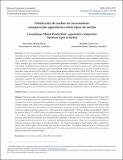Mostrar el registro sencillo del ítem
Producción de melón en invernadero: comparación agronómica entre tipos de melón
| dc.creator | Monge Pérez, José Eladio | |
| dc.creator | Loría Coto, Michelle | |
| dc.date.accessioned | 2019-03-05T15:55:42Z | |
| dc.date.available | 2019-03-05T15:55:42Z | |
| dc.date.issued | 2017 | |
| dc.identifier.citation | https://investiga.uned.ac.cr/revistas/index.php/posgrado/article/view/1966 | |
| dc.identifier.issn | 2215-2172 | |
| dc.identifier.uri | https://hdl.handle.net/10669/76657 | |
| dc.description.abstract | Se evaluaron siete tipos (Amarillo, Cantaloupe, Charentais, Galia, Harper, Honey Dew y Japonés) de melón (Cucumis melo L.), producidos bajo invernadero en condiciones hidropónicas en Alajuela, Costa Rica, para determinar su rendimiento y calidad, tanto a nivel cualitativo (una variable) como cuantitativo (seis variables). Todos los genotipos de los melones tipo Amarillo, Honey Dew y Japonés presentaron plantas andromonoicas, mientras que en los demás tipos se presentaron tanto genotipos monoicos como andromonoicos. Los datos muestran una amplia variabilidad entre los tipos de melón en cuanto a número de frutos por planta (1,18 – 3,26), peso promedio del fruto (443,29 – 837,03 g), rendimiento por planta (685,08 – 1882,13 g), rendimiento por área (17,79 – 48,89 ton/ha), firmeza de la pulpa del fruto (14,91 – 20,40 N) y porcentaje de sólidos solubles totales (12,48 – 15,33 °Brix). El mayor número de frutos por planta se obtuvo en los tipos de melón Amarillo (3,26) y Japonés (2,79), mientras que el menor número se obtuvo con Cantaloupe (1,48) y Galia (1,18). Los frutos con mayor peso promedio se obtuvieron con los tipos Honey Dew, Cantaloupe y Japonés. No se presentaron diferencias significativas entre tratamientos para la firmeza de la pulpa del fruto. El mayor porcentaje de sólidos solubles totales se obtuvo con los melones tipo Honey Dew, Amarillo, Harper y Japonés. El mayor rendimiento por área se obtuvo con los melones tipo Japonés y Honey Dew (48,89 y 47,51 ton/ha, respectivamente), por lo que se consideran los más recomendables bajo las condiciones en que se desarrolló el ensayo. | es_ES |
| dc.description.abstract | The Seven melon (Cucumis melo L.) types (Yellow Honey Dew, Cantaloupe, Charentais, Galia, Harper, Honey Dew, and Japanese) grown in greenhouse and hydroponic conditions in Alajuela, Costa Rica, were evaluated to compare their yield and quality both in qualitative (one variable) and quantitative (six variables) terms. All genotypes of Yellow Honey Dew, Honey Dew and Japanese melon showed andromonoecious plants, while the other melon types included both monoecious and andromonoecious genotypes. Data show a wide variability between melon types with respect to number of fruits per plant (1.18 – 3.26), mean fruit weight (443.29 – 837.03 g), yield per plant (685.08 – 1882.13 g), yield per area (17.79 – 48.89 ton/ha), fruit flesh firmness (14.91 – 20.40 N) and percentage of total soluble solids (12.48 – 15.33 °Brix). The highest number of fruits per plant resulted from Yellow Honey Dew (3.26) and Japanese (2.79) melon types, while the lowest results were obtained with Cantaloupe (1.48) and Galia (1.18). Fruits with the highest mean fruit weight resulted from Honey Dew, Cantaloupe and Japanese melon types. There were no significant differences between treatments with respect to fruit flesh firmness. The highest percentage of total soluble solids resulted from Honey Dew, Yellow Honey Dew, Harper and Japanese melon types. The highest yield per area was obtained with Japanese and Honey Dew melon types (48.89 and 47.51 ton/ha, respectively), so these are considered the most recommended under the conditions tested. | es_ES |
| dc.language.iso | es | es_ES |
| dc.source | Revista Posgrado y Sociedad, vol. 15(2), pp. 79-100 | es_ES |
| dc.subject | Cucumis melo | es_ES |
| dc.subject | Calidad | es_ES |
| dc.subject | Rendimiento | es_ES |
| dc.subject | °Brix | es_ES |
| dc.subject | Peso del fruto | es_ES |
| dc.subject | Cucumis melo | es_ES |
| dc.subject | Quality | es_ES |
| dc.subject | Yield | es_ES |
| dc.subject | °Brix | es_ES |
| dc.subject | Fruit weight | es_ES |
| dc.title | Producción de melón en invernadero: comparación agronómica entre tipos de melón | es_ES |
| dc.title.alternative | Greenhouse melon production: agronomic comparison between types of melon | es_ES |
| dc.type | artículo original | |
| dc.identifier.doi | 10.22458/rpys.v15i2.1966 | |
| dc.description.procedence | UCR::Vicerrectoría de Investigación::Unidades de Investigación::Ciencias Agroalimentarias::Estación Experimental Agrícola Fabio Baudrit Moreno (EEAFBM) | es_ES |
Ficheros en el ítem
Este ítem aparece en la(s) siguiente(s) colección(ones)
-
Agronomía [1485]


